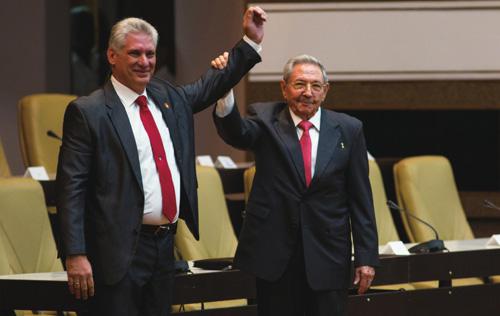Friends And Comrades
2018-05-22
Cubas First Vice President Miguel Díaz-Canel was chosen as the new Cuban president on April 19, marking the start of a new era for the country and the Sino-Cuban relationship. In a recent interview with Beijing Reviews Rebeca Toledo, Cuban Ambassador to China Miguel ángel Ramírez Ramos shared his views on the recent change in leadership and the dynamic future of bilateral relations with China.
Beijing Review: China and Cuba have had a fraternal relationship for almost 60 years. How would you describe the friendship between these two socialist countries?
Ramírez: Relations between the two countries were established in 1960, in the midst of the Cold War. It was an act of political will to recognize the Peoples Republic of China which had arisen in 1949. Since then, relations have strengthened in all political and economic spheres based on the fact that the two countries pursue socialism with their own characteristics directed by communist parties.
This relationship also has a profound historical base. It goes back over 170 years when Chinese workers started arriving in Cuba, totaling around 150,000. In Havana there is an obelisk dedicated to those that fought in our independence struggles that says there were no Chinese-Cuban traitors or deserters.
Cuban culture and identity is a great stew filled with many influences, and Chinese immigrants have contributed their own unique cultural component. For example, the Carnival of Santiago de Cuba can only begin after the Chinese trumpet is played while Chinese dishes have been incorporated into our culinary diet.
China is something that is inside of us; our relations are not only external, we see China as part of Cuba too. There is a long involvement between the two countries that we continue to cultivate and develop in a systematic way that has many prospects for the future.
The China-proposed Belt and Road Initiative has sparked Cubas interest, what role can Cuba play in this global project?
Cuba has actually been a part of the Maritime Silk Road for over 300 years. Starting in the 16th century, Chinese ships traveled from Fujian to the Philippines with goods that then headed toward Mexico. After traveling through Mexico by mule, the merchandise was shipped from Yucatan to Cuba, and fi nally to Spain. That was the fi rst Maritime Silk Road in Latin America.
Today, Cuba is very interested in the Belt and Road Initiative. In January of this year, the China-CELAC (Community of Latin American and Caribbean States) Forum was held in Chile, where it was agreed upon to move forward with the concretizing of the Belt and Road Initiative in the region.
China can not only count on Cuba to promote bilateral projects, but also as a bridge for Chinas access to other markets. We see the Belt and Road Initiative as a new type of globalization. It is not the neoliberal globalization of the United States, but one based on mutual benefi t. The key is connectivity, including digital, info-communications, rail and maritime. Several Caribbean countries have problems of connectivity and Cuba is willing to play the role of a facilitator in this area.
In Latin America, there have been advances in exploring and defi ning potential agreements. These include a railway through Bolivia to the Atlantic Ocean and a railway from Panama to Mexico. China is also making advancements with the Internet. Huawei is currently exploring 5G, which would greatly contribute to the economic and social development of our region.
Chinas trade in Latin America has grown in the past few decades, with an increase of investment recently. Where do you see opportunities for more collaboration in the region?
In 2016, our bilateral trade surpassed $2.5 billion. China is Cubas number one trade partner in goods. Today, the Chinese presence covers practically every sector of the Cuban economy, including machinery, transportation, energy and agriculture.
Chinese investment is advancing in Cuba but is not at the level we would like, nor fulfi lling the potential of what is available. We recently signed a contract with a company in the real estate and tourism areas for $500 million and we are about to close on a Chinese investment deal in Mariel for the production of tin cans.
In terms of Latin America, trade between China and the region surpassed $260 billion in 2017, with China now the fi rst or second trade partner of many countries in the region. Chinese investment is starting to grow, especially with products associated with Chinese imports like minerals and agriculture, and Chinese exports such as technology and machinery.
Cuba just wrapped up its electoral process on April 19. Can you tell us about popular involvement in your elections? How are candidates chosen for the National Assembly?
The electoral system in Cuba is very democratic, with broad popular participation. It is a pyramid structure where democracy starts at the base in the constituencies. No one is identified with any political party. Electoral campaigns dont exist like in the United States, where billionaire lobbies are the ones that pick the president. In Cuba, not one penny is spent on elections.

The Communist Party of Cuba (PCC) does not nominate or designate any candidate. The PCCs role is to safeguard the smooth functioning of the electoral process. There are many candidates not affiliated with the PCC like religious leaders who are elected from the base.
For provincial and national elections, half of the deputies are elected by direct and secret vote from the base while the other half is made up of candidates suggested by mass organizations. The National Assembly of Peoples Power (ANPP) elects 31 members to the Council of State, which makes decisions in between the ANPP sessions, which take place every six months. As the maximum organ of executive and legislative power, the ANPP issues laws, but in between sessions the Council of State issues decrees that are subsequently confi rmed by the ANPP. The presidential candidate must fi rst be elected to the ANPP, then to be a member of the Council of State by the ANPP deputies and subsequently elected by the council.
Since the topic of democracy in Cuba is often linked to the fact that there is only one political party in Cuba, we must emphasize that the PCC is not an electoral party. It is a party that the Constitution defi nes as the guide and overseer of society. This tradition is part of our history dating back to the 19th century when José Martí formed the Cuban Revolutionary Party to guarantee the unity of the people.
Can you tell us more about the new President Miguel Díaz-Canel and the Cuban vision for the future?
The recently concluded process confirmed a generational transition tied to historical continuity. The new president, Miguel Díaz-Canel, will not break with the basic principles of the revolution set forth by its founding leaders, Fidel and Raúl Castro.
Fidel once said, when talking about the leaders of the revolution of 1868, “We would have been like them, and they would have been like us today.” This means, like Karl Marx said, that people are more similar to their times than to their parents. Díaz-Canel is a man of his time. But if Fidel or Raúl were in his place today, they would do as Díaz-Canel is going to do.
I add this because sometimes it is said that Raúl was a reformist. But if Fidel had continued after 2006, the reforms that have taken place would have happened all the same. Raúl responded to historical conditions by updating the economic model to be in sync with the 21st century and the demands of our people.
Díaz-Canel was born in 1960 after the triumph of the revolution in 1959 and is a child of the U.S. blockade. About three quarters of the population in Cuba was born under the blockade, which aims to put obstacles on our trade with other countries and our financing, and whose impact on the Cuban economy has surpassed $200 billion.
In the coming period, we will continue to update and advance our new economic and social model. The speed in which we do it will depend on our efforts, as well as the limits of the blockade.
We will continue to build socialism—democratic, prosperous and sustainable. The main means of production will continue to be in the hands of the state, with different forms of property and property management continuing to develop. A hotel or restaurant that does not function effi ciently in state hands will be rented to a person or cooperative that will make it function better and pay taxes to the state, who will continue as owner.
Property may be given to a person in areas that are not fundamental such as small restaurants or barbershops. We will continue to work on the agricultural sector, where about 75 percent has been privately owned for many years now, with small farmers often organized into agri-cooperatives.
We remain committed to elevating peoples well-being, guaranteeing their health, education, social security and prosperity. We will make education and healthcare more efficient but they will continue to be free.
We think China and Cuba are at a historical moment in bilateral relations evidenced by the high level of interchanges that have taken place in the past few years that indicate there is a high level of political dialogue taking place.
The congratulatory messages from President Xi Jinping to Díaz-Canel and Raúl were the first we received in Cuba. They were the first to be made public and included a warm message and political promise of friendship in the coming era. As Xi said, Cuba and China will always be friends, brothers and comrades.
